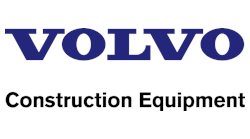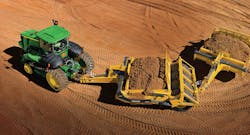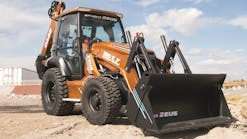If you’re having trouble keeping up with the marketplace for mapping and machine control, don’t feel bad. It’s evolving at a frantic pace, and the technologies keep getting more sophisticated. In fact, taking a walk through a trade show with displays from the major manufacturers can be staggering. So much so that you need a map just to find your way around a single booth! Nonetheless, this technology is the way of the future, and that’s why we’re bringing you our version of a map, complete with guideposts (industry experts) that can help you find the way to a profitable solution.
To start, let’s talk with Bruce Flora, PLS, Flora Surveying Associates, Glenns, VA. Flora has been a surveyor and consultant for the construction industry for more than 20 years, and the last 17 have been very busy helping contractors with mapping and machine control equipment. “The technology has grown rapidly,” says Flora, “but it’s only as powerful as the guy at the keyboard. We see that a lot of people need training, and I teach my customers how to do their job using software, so we look at their tasks and workflow, and how they can use software to do the job they did previously by hand.”
Flora’s point about training is critical to your success with mapping and machine control software. All of our experts agreed that no matter the size of a contractor’s organization, it’s important to have a trained, full-time manager of mapping/digital technology on your staff. As a bonus, the new position can offer a career path promotion for somebody within the organization. For example, Ed Shappell, director technology solutions and services at Trimble, Broomfield, CO, notes that the future resource dedicated to owning the technology is often waiting in the wings. “Many times, we will see a survey manager become the data manager on a project,” says Shappell. Ultimately, they should be dedicated to being responsible for guiding the organization’s adoption of technology, managing projects, and staying on top of the changes in software and hardware.
So, before you buy, make sure you’ve filled the position of technology manager. Now comes the fun part—let’s get some advice on how to go shopping! “I do a lot of interviewing of customers to set up programs to help them grow as quick as possible,” says Flora. “As far as a type of product, we are hardware agnostic. The main thing is to make sure you have a good dealer, because, for those first one to three years, you’re going to depend heavily on the dealer to help get you through it. You’re buying a new technology, and if there’s a problem, it’s the dealer that can supply good backup, inventory parts, and troubleshooting people.”
Is there a contractor on planet Earth that isn’t familiar with the need for backup, inventory, and troubleshooting? Those requirements are the foundation of any good dealership, according to Johan Larsson, general manager at SITECH Norcal, San Leandro, CA, an authorized Trimble Civil Engineering and Construction dealership. However, adopting mapping and machine control takes the contractor and dealer into entirely new territory, says Larsson. “The biggest thing for us is helping contractors change the process of doing construction. The process isn’t just getting the bid, it’s getting the data out to the field to complete the job. Now an estimating department that has been in charge of coming up with volume calculations and estimates for the job has to create a model that’s accurate enough to use in machine control.”
For many contractors new to the technology, creating a three-dimensional (3D) model can appear to be a daunting task. But manufacturers have been simplifying the process, and with so many global navigation satellite systems (GNSS) based surveying products on the market, it’s within the realm of most any contractor’s capabilities and budget. Moreover, for those contractors that want to take advantage of the benefits from cutting edge technology, there’s the new wave of unmanned aerial vehicles (UAVs) products. Call them UAVs, or call them “drones”—these systems make it possible to accurately survey hundreds of acres in less than an hour. We’ll talk more about them later, but the critical point here is that even if the project bid materials include survey data, it’s risky to use the data for estimating and project execution.
According to Flora, before you develop a bid, the first thing you should do is go to the site, check the control point (the surveyor’s marker), and do a topographic survey. “One of my contractor customers went out and did a survey and checked it against the plans, and found it would cost $60,000 more to follow
the plan that was supplied, because it was wrong. On a 50 to 60 acre site couple of inches floating around can equal a lot of money. On a project for high occupancy transit lanes from Washington DC down to Fredericksburg, Virginia, my customer was doing the stone, and another contractor was doing the paving, and if they would’ve followed the plans, they would have been $100,000 apart in cost.”
Steve Warfle, product manager, InSite Software Inc., agrees, adding, “In the dirt industry a big challenge is the quality of the topo data. If there’s a new project such as a high school or strip mall, for the grading portion of it the contractor gets topo maps with basic information. But sometimes they aren’t accurate because they came from historical data or an aerial. So contractors need to get an accurate topo because these commercial projects are typically done as a lump sum, and if you win the bid, regardless of whether there’s more or less quantity, that’s the amount you get paid. Manufacturers such as Topcon, Leica, and Trimble allow a contractor to survey and do data collection by walking the site with a GPS rover or robotic station, or automate it with a system on a vehicle. The technology gives you a very accurate topo of the job site.”
InSite’s product takes that data and imports it directly, so you minimize your risk by having an accurate topo, and you can generate as-built quantities. In some cases in development you may have the need to quantify the portion of the job you’ve already done. So you might want to do as built quantities by shooting a secondary topo and comparing. “Our software allows you to take that data and generate quantities,” says Warfle, “and that’s why our customers use that component of our software. Reducing risk is what it comes down to.”
With all the power of the InSite system, it may look like a heavy investment in learning time, but don’t worry, you can learn it at your own pace—online, and quickly. InSite moved all of their training classes online to fit the estimators’ schedule rather than forcing them to travel and leave the office for training. The beginner class runs about five hours and then additional classes run about two hours per segment. “We can even log into their machine and take over their mouse to show them exactly how to accomplish a task on their job,” says Warfle.
InSite makes an add-on component to export the takeoff file directly to a machine control system. “We support all manufacturers so you can take that information and add detail that the model needs and take it to the field and start grading,” says Warfle. “One of the things we find is that end-users are overwhelmed by the data component, but that’s what our Field General software and training is for. It lets them prepare the data correctly.”
Before we leave the topic of collecting accurate data, let’s take a closer look at surveying. There are many manufacturers, such as Topcon, Leica, Carlson, and Trimble, that offer surveying hardware and software suites. These software suites are very powerful tools. For example, let’s look at Carlson SurveyGNSS, Maysville, KY. The company’s latest software is designed for simple, yet powerful data post-processing. It works with Carlson SurvCE and SurvPC data collection software, and with Carlson’s office design software. Features include the ability to determine candidate vectors for simultaneous calculation, instead of one-by-one, so users will be able to start another task while SurveyGNSS is still working on a computation. Constellation and reference networks are critical to a survey’s accuracy. SurveyGNSS supports the International GNSS Service [IGS] and 10 other satellite networks.
Alphatec Surveyors LTD, Chesapeake, VA, uses Carlson Point Cloud, with their UAV, plus Carlson Takeoff, and Carlson Civil Suite, to create automated machine guidance files. The files are converted with Carlson CADnet to paper files received from engineering firms. Carlson products are used for projects including property lines, boundary lines, topographic, hydrographic, geodetic land surveying, and construction stakeouts, in addition to the creation of automated machine guidance files.










